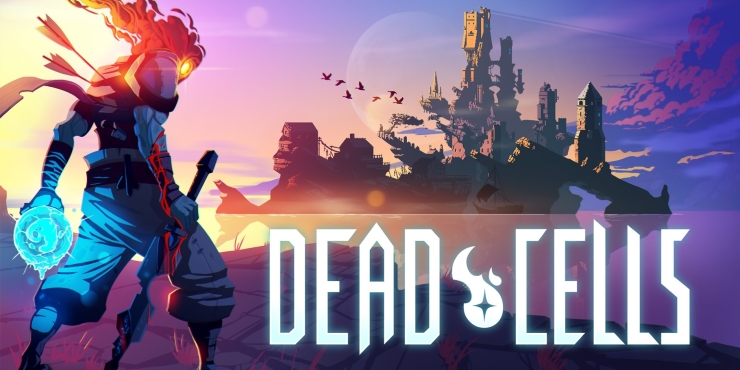
Rogue-like Dead Cells is one of the most fair yet challenging games I have played in a long time, despite relying on RNG for procedurally generated levels and spawning random weapon. It is not perfect, but damn close enough to it that improving your own skill can get you over the hurdles thrown at you – read on to find out how the game stacks up.
Dead Cells
Publisher: Motion Twin
Developer: Motion Twin
Platform: PC, Mac, Linux, PlayStation 4, Xbox One, Nintendo Switch (Reviewed)
Release Date: August 7th, 2018
Players: 1 Player
Price: $34.99 Physical ($24.99 Digital)
In Dead Cells you are… Something. You seem to be some sort of blob that quickly gains new life by rooting itself onto the neck of a recently beheaded man, and turning into a fire-headed undead ninja-man.
While that might sound glamorous, you still are quite within mortal-ish limitations. To make matters worse, you seem to be in some kind of prison. You slowly learn of a plague called “The Malaise” that seems to have mutated people, and needed some pretty harsh containment methods. Hence the prison filled with monsters.
The story is light but gracefully hinted at with background details and rooms you find that have hints of lore. You also get snippets of your own character’s thoughts- revealing some surprisingly wry humor.
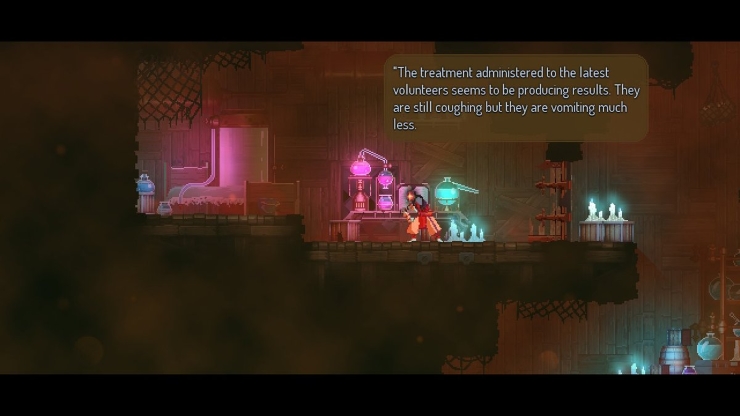
As a side-scrolling action game, you explore randomly generated areas, fight monsters, and do the odd bit of light platforming. The fact you later unlock abilities to interact with different objects in the environment to access new paths has led to it being compared to metroidvania games.
The comparison is not really apt. As all levels are randomly generated, you can not revisit old areas with new skills. However, you can still find the strange objects to interact with that let you access new areas and levels once you have the appropriate “rune” unlocked. It is closer to a rouge-lite where you unlock something new or your next run than anything.
Along with money and cells to unlock new weapons and mutation abilities, you find scrolls that increase one of three stats. Brutality, Tactics, and Survivability. Each one correlates to a playstyle that can affect how much damage you do with weapons, and how effective certain mutations are.
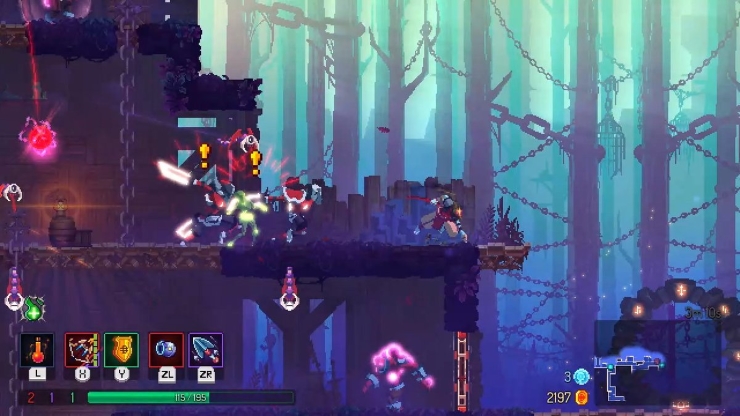
Brutality weapons are typically melee and get crits under certain criteria, with mutations that increase damage based on certain conditions. Tactics have bows and improves the power and speed traps are deployed. Survivability meanwhile offering shields and the heaviest and slowest weapons. Their mutations increase your total health or allow healing.
As you level up in these stats, they increase the damage weapons of their type do. They also increase your total health with diminishing returns. So even if you are going for a Brutality and Tactics based run, you may want to dip into Survivability to get an extra 50% health.
While initially experimenting between dodge rolling and parrying with a shield, I unlocked more weapons, mutations and secondary weapons (traps and grenades), and became showered with synergies and strategies. This was further helped by Diablo-style modifiers on weapons. “+15% to Burning enemies”, “Victims freeze nearby foes”, etc.
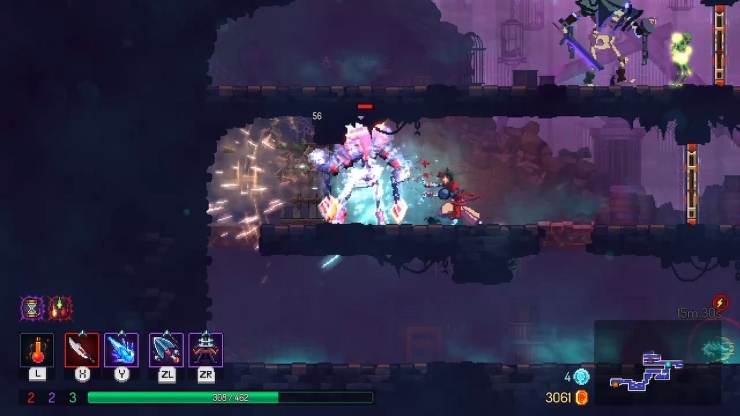
For example: I could shoot foes with my Freezing Bow, which also caused my enemies bodies to catch fire when they died. Then I could dodge-roll behind them and stab them in the back with my daggers which deal crits when attack from behind- with the additional modifier that deals extra damage to frozen enemies.
However, this all evaporates once you realize the “best” method. Stripping enemies of their ability to move or act is king. Anything that can hold them in place or stop them attacking (such as a Wolf Trap or Freeze Grenade) is a god-send for faster enemies later on that attack in large groups and endlessly assault you.
Combined with another secondary weapon that can pile on damage while a foe is on lock-down (like a crossbow turret or sawblades) and even bosses can quickly be turned into a joke. Albeit, one you need to be careful around while you are waiting for your Wolf Trap to come off cool down. In fact, bosses that rarely touched the ground became more of a challenge because of this.
It can be frustrating to learn that is the best way to go after experimenting with other things, but it is only a half truth. It makes life easier, but not easy. The whole game encourages you to get better, and that no build of weapons and mutations is wrong- just easier, harder, or personal preference. Perhaps the above is just what I found worked best.
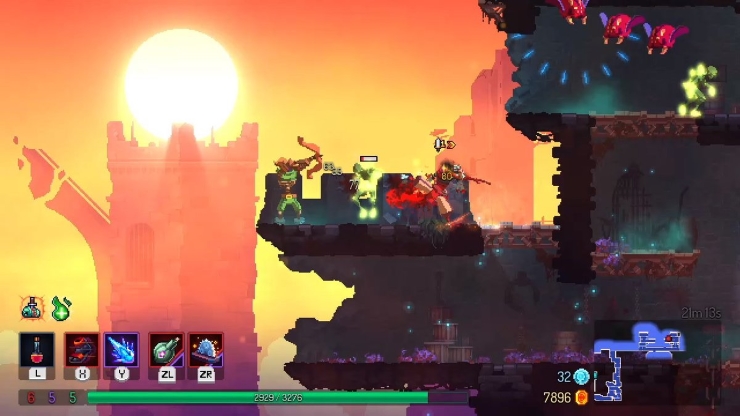
I felt the vast majority of the weapons were all viable in one way or another. Though personally heavy weapons were too slow for me in later levels against large groups of fast enemies.
As the game gives you random weapons to find and you unlock more to add to your pool of weapons via blueprints, you are quickly encouraged to adapt. Weapons in later areas become a higher level so you need to switch to a newer weapon of the same color that you are currently built for. As such the weapons you find early on can easily change your playstyle on each run.
You are not even technically “locked” into a playstyle during one run either. You can pay to reset what mutations you are using, and all levels in Brutality, Tactics, and Survivability still increase your total HP. So you can start using melee weapons and shields, then switch to bows and traps because you found something really powerful.
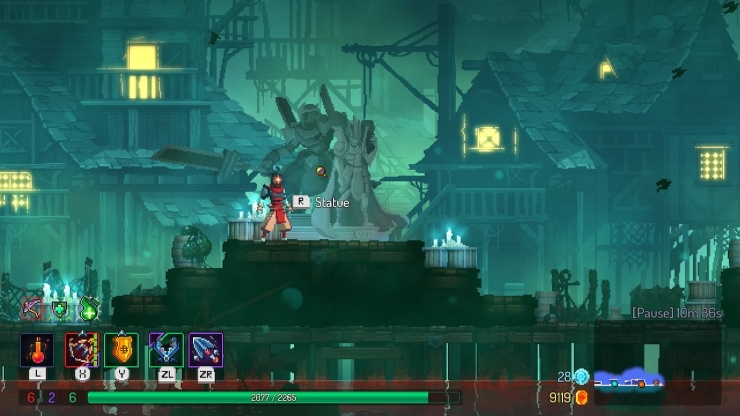
You can even choose to partially spend Cells on new weapons and mutations. Since you can “bank” them so they are not lost when you die, you can spend all but the last Cell. When you finally buy a new weapon you get it for free, right there and then. It is a great trick to for when you need a better weapon on a run, though I found myself hardly needing to rely on it.
Despite the large range of weapons I could find, I rarely felt like I was screwed over by bad luck. Sure there was moments I did not like the selection of starting weapons I had, and runs where I was praying for a higher level weapon of a particular color or style I liked- but these were few and far between.
As long as I explored each area a decent amount, I could usually find a more powerful weapon that fit my playstyle and build. Or I could even change my build based on what was available. I felt any time I lost was due to acting hastily or a mistimed dodge-roll or parry. The great thing about the game is no matter how you play, you can go far if you “Git Gud”.
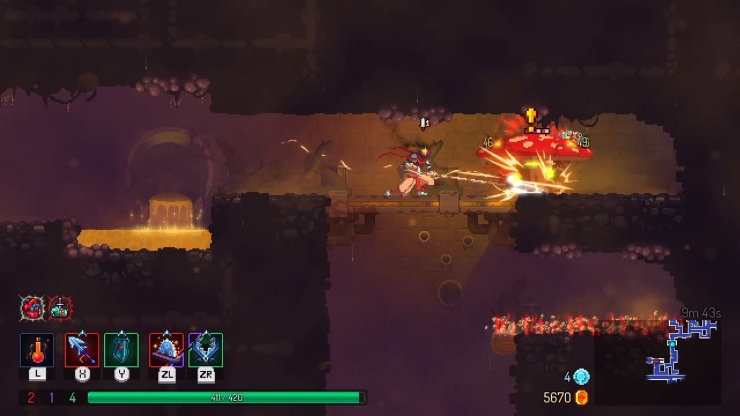
The game heavily encourages speed-running to aid in this. If you kill enough enemies in a short time, you run faster and get a neat ninja-running animation. To keep this increased speed up, you need to keep killing every so often (though initially there were a few times I lost it due to long empty corridors). It helps kick the idea of a passive speed run out the window.
In addition, the player can move very fluidly. You quickly vault up ledges if you are close enough, and can quickly land with an almighty stomp. Secret rooms or rooms with chests (where you can spend time to think about if you want the item or not) even freeze the timer, so you stay as long as you wish.
You also have speed-run challenges in a random small dungeon. These can be quite difficult if they choose an area you have not explored yet as their template, not to mention you need to defeat a boss under a time-limit. Since the boss’ room is signposted, there’s very little incentive to explore unless the weapons you find on the major “path” to the boss are not good enough.
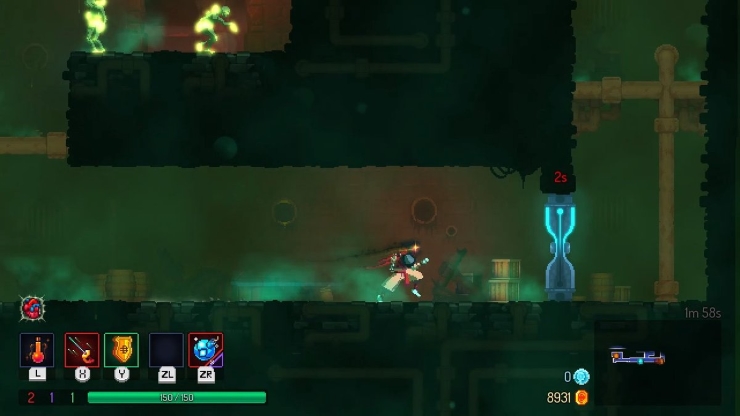
Other than online leaderboards and self-satisfaction of beating the daily challenge fastest or with the most points, it is one of the few times the random generation works against it. You can unlock more blueprints for the main game if you beat daily challenges enough times, but outside of that the mode pales in comparison to attempting to speed-run the main part of the game.
The biggest encouragement to use speed-running tactics is Timer Doors. Certain areas have a door with a timer that will lock after a certain amount of time has passed on a run. Too long and it locks. Otherwise you get extra money, cells, and even a blueprint if it is your first time getting into that room.
It seems that you get more Cells this way than clearing out an area, but less money and scrolls. You unlock things quicker by going fast, or learn more about enemies and build up the stats for the run that could beat the final boss if you take your time- risking more enemies getting the chance to hit you. It is a beautiful synergy that allows you to enjoy one playstyle and dip your toe into the other.

With how levels are generated, it can be hindered however. Levels seem to either be a maze, or very horizontal with “branches” going down or up. While in the latter exits and timed doors are in the same place, on the former exits to the next level can be much harder to find. On a few occasions I never had a chance of finding the next level to get to a timed door in time.
One of my few other qualms is how Elites go against what you have learned. While they drop Runes you need to access new areas or powerful weapons, they attack at an alarmingly fast rate and summon enemies to aid them.
Due to how large and aggressive the mob is, I quickly found myself having to abandon well laid plans and relentlessly attack- hoping to kill it before it killed me. While so many other enemies and bosses have clever ways to fight them, I felt the Elites were a tad unfair. Though not nearly as bad as the Golems who have a stunning attack that is a little too fast for my tastes.
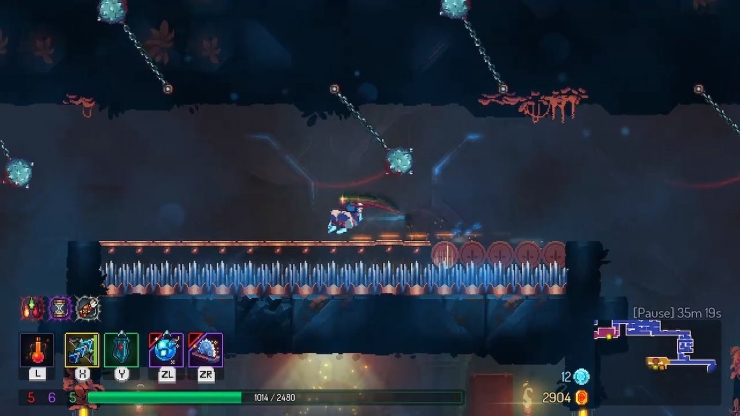
Each level after the first has a gimmick of some form. Pools of toxic water, needing to find a key to access the rest of the level, having to step back into the light to stop enemies from hurting you, and so on. Even in levels where a gimmick or major enemies are repeated, a new gimmick or enemy works in conjunction with it (or at least one from another area).
The path to the final boss is a twisting one. Rather than two branches leading to the same point, the various areas seem to snake into one another, meaning you can fight more or less areas depending on the path you take. Eventually you learn what abilities in what areas can take you to, but an in-game reminder would have been nice.
Levels also have hidden passages to secret rooms. One or two particular hidden blue-prints can be a little cryptic to find, especially since the hints to their hidden rooms are very subtle- something that is only out of place in particular levels. I honestly do not know how you would find it outside of an accident or a guide.
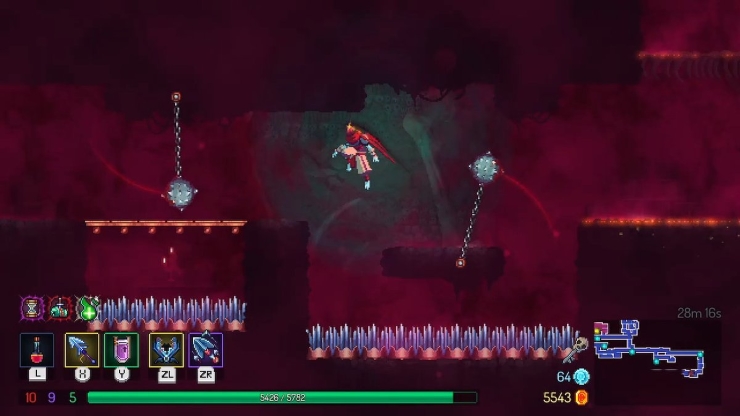
Pixel art is usually a red-flag due to how some poorly use the style. This is far from the case here as the game looks gorgeous. Each enemy and the player character almost look like they were drawn and animated first before a pixel filter was put over the top of them. Though the individual fake “pixels” maybe slightly too big for some.
The backgrounds are similarly beautiful, with each area having a unique feel. Even areas you think would look identical (the Toxic Sewers and the Ancient Sewers for example) avoid using pallet swapped assets whenever possible and have unique details that you will not find in other levels.
As a minor nitpick, the platforms in the Toxic Sewers looked like they were part of the background at first. Brass pipes that sometimes jut out only a little bit. While you should always be able to know what is a platform from the get-go, this is the only incident I had like this.
The music is sombre and creepy based on where you are, with boss battles being far more dramatic and pounding. The real highlight is the sound effects though. Satisfying whacks and slices ring out with you and your foes attacks.

Dead Cells could have been a disaster – another game where your arm is behind your back unless you get lucky. Instead your skill is rewarded, and even when enemies become frustratingly fast, you always get the urge for just one more run. Good luck does help of course. It is not perfect, but it is dead close.
Dead Cells was reviewed on Nintendo Switch using a review copy purchased by Niche Gamer. You can find additional information about Niche Gamer’s review/ethics policy here.
The Verdict: 8.5
The Good:
- RNG that avoids screwing you over as much as possible.
- Satisfies those who speedrun or explore every square-inch.
- Fast and rewarding combat.
The Bad:
- Immobilizing tactics are really the only way to go
- Elites and one particular enemy can be a little unfair.
- Randomly generated levels can ruin speedruns in rare instances.